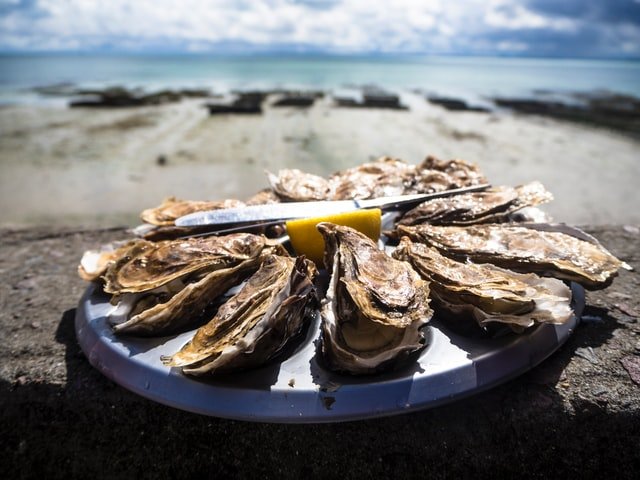
Oyster
Oysters are grown on oyster beds, which act as habitats for several other marine species. Oysters are filter feeders, filtering seawater to obtain their food, and in doing so improving water quality and clarity.
IN SEASON
January – December
CATCH METHOD
Aquaculture
ABOUT THE FISH
Oyster
Oysters in Jersey are cultivated through aquaculture along the east coast of the island, predominantly in the Royal Bay of Grouville. The oyster industry was enormous in the 19th century, with an estimated 2,250 million oysters exported over a 20 year period. However, like many places around the UK and English Channel, oyster stocks collapsed due to overfishing and the oyster industry suffered as a consequence.
Historically, Jersey was home to the native oyster (Ostrea edulis). With the collapse in native oyster populations, Pacific oysters (Magallana gigas) were introduced. This resulted in such a dominance in Pacific oysters that it’s now rare to find a native oyster in the wild.
Oysters are a great source of protein and other important nutrients such as zinc, copper, iron and calcium. They also contain Omega-3 fatty acids and a suite of vitamins.
LOW-IMPACT CATCH METHODS
Aquaculture
Oyster farms consist of rows of oyster beds located near the low water mark. These beds are made up of mesh bags, inside of which sit the oysters. The bags are kept elevated above the ground to keep the oysters sand-free.
Pacific oysters grow for about 18 months until they reach market size. The largest oysters are grown for up to three years. Once they have reached the desired size, the mesh bags are lifted and transported to a sorting unit. Here, the oysters are emptied from the bags and then cleaned ready for eating.
Before harvest, oysters which are due for a longer journey are moved to holding areas, closer to the high-water mark, where they are exposed to more daylight. As a result, the oysters become accustomed to being out of the water, helping to keep them as fresh as possible.
PREPARATION ADVICE
Oyster
Oysters are simple to prepare – all you need is a tea towel and a shucking knife. A shucking knife is a sturdy, short knife. It doesn’t need to be sharp, as its purpose is to prise open the shell. If you don’t have one of these, a small, sturdy knife with a thick blade will do.
Hold the oyster in the tea towel with the curved side in your palm. Take the shucking knife in your dominant hand and insert the tip into the pointed end. You’ll find a weak spot between the upper and lower shell. Work the tip of the knife in, and begin to slightly twist it back and forth. Continue to do this while pushing the knife further in until the upper shell pops away from the lower part of the oyster.
Before removing the top shell, scrape any meat off. The meat is held to the lower, curved part of the shell. All that’s left to do is to cut away the meat with the shucking knife. Your oyster is now shucked!
Alternatively, if you don’t fancy the challenge of shucking an oyster, or you don’t have the necessary knife, then a simple trick is to quickly grill or bake the unopened oysters.
To do this, place the oysters curved side down on a tray then roast or grill them for one minute. Once the shell has popped open, you should be able to easily remove the lid of the oyster and proceed with the rest of your recipe.
COOKING ADVICE
Eating Oysters
Oysters can be eaten both raw and cooked, making for a versatile ingredient. Traditionally, oysters are enjoyed raw with a few drops of hot pepper sauce and lemon juice.
If raw isn’t your style, then simply add a dollop of garlic butter and grill them! The grill should be nice and hot and you’ll want to cook them for about five to six minutes, until the edges of the meat start to curl.






